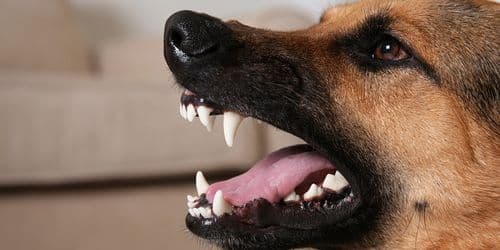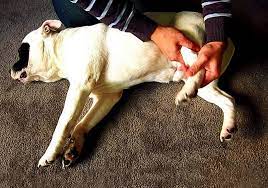When you know how old your dog is, you’ll be able to decide what to feed them and how to adequately take care of them. How then will you be able to tell how old your dog is? Learn about it in this chapter.
How To Tell How Old A Dog Is
#1. Examine Their Teeth
According to the Humane Society of the United States, the most reliable technique to assess a dog’s age is to check its teeth. If your dog is still a puppy, you can estimate its age by observing the growth of its chompers. Puppies under four weeks old are likely to have no teeth, whereas puppies aged four to eight weeks have needle-sharp temporary teeth.
Your puppy’s permanent teeth will appear when he or she is three or four months old, and they will remain clean and sparkling white until they are about a year old.
Your dog’s teeth may begin to show signs of deterioration after the first year of life. Initially, you’ll see stains and plaque on their teeth in the rear of their mouth. Most dogs’ teeth will be slightly yellowed and have noticeable plaque by the age of three. Dogs around the age of five have a lot of tartar, teeth that are less pointed or even somewhat worn down and are more prone to dental problems. Dogs over the age of 10 are more likely to have loose, broken, or missing teeth.
#2. Examine Their Coats
Most dogs, like humans, will begin to gray as they age. Your dog is likely to get some gray or white on their muzzle, chest, or haunches between the ages of seven and 10.
According to The Bark, the early appearance of gray fur is not always a symptom of age and might actually be the result of stress or anxiety, much like in people.
#3. Examine Their Eyes
Another area where your dog’s age can be seen is in their eyes. As a dog gets older, his or her eyes may become clouded or discharged. This is a normal part of the aging process that normally begins when a dog is between the ages of six and eight years old, but it’s still a good idea to consult with your veterinarian to ensure the change isn’t harming your pet’s vision or giving them discomfort.
As dogs age, some will lose their vision completely or get cataracts.
#4. Pay attention to their hearing
Vision isn’t the only sense that might change as your dog ages. Younger dogs often have excellent hearing (particularly if you’re opening a bag of treats! ), but an elderly dog may have difficulty hearing you approach or responding to your call.
Your veterinarian can check for hearing loss and assist you in caring for a dog who is deaf.
#5. Consider Their Muscles and Structure
Puppies’ bodies are soft and rounded, with little muscle tone. They are also prone to have big paws and ears. In good health, young and middle-aged dogs have visible muscles and a sleek, defined shape. An older dog may have less muscle tone, carry a little extra weight, or begin to grow bony.
#6. Take note of your mobility and activity level.
If your dog is young, he or she will likely move easily and be eager to play or chase. According to petMD, as dogs age, they become less energetic and may have trouble moving up and down stairs, jumping, or running.
Older dogs may be less interested in playing and may choose a nap on the couch to a romp in the park. Keep an eye on your dog’s activity level and gait for signs of stiffness or restricted joint mobility.
#7. Take account of genetics
While these approaches may assist you in estimating your dog’s age, not all dogs age in the same way. Depending on their breed, medical history, nutrition, and level of exercise, your dog may show signs of aging sooner or later in life.
Consult your veterinarian to learn more about your dog’s physical health and what you can do to help them age gracefully, and use our dog years calculator to estimate your dog’s longevity.
How to Tell How Old A Dog Is By Teeth
Examining the teeth of an adult dog will give you a very rough estimate of the dog’s age. Because pups typically shed their baby teeth at a specified age, the age may be approximated with more accuracy in puppies. While the teeth can only provide a general estimate of the dog’s age, it’s a decent place to start. Before we go into how you can tell the age of your dog age by teeth, here are some fundamental things you should know.
Understanding the Teeth of Your Dog
#1. Be familiar with the structure and organization of your dog’s teeth.
Every dog has four fundamental tooth types: incisors, canines, premolars, and molars. These can be present on both the left and right sides of the upper and lower jaws.
The incisors are the tiny teeth that run down the front of the mouth. Adult dogs have six incisors on top and six on bottom of the jaw. The two side incisors (next to the canine teeth) are slightly larger than the center incisors; on top, they also protrude to the side slightly more.
The canine teeth, one on each side for a total of four, are placed behind the incisors. These are the sharp, big teeth.
Canines are followed by premolars. Both the upper and lower jaws have four premolars. The top fourth premolar is quite massive.
Finally, the molars appear behind the premolars. Two molars are located on the roof of your dog’s mouth. Three molars are located on the bottom jaw. The first is significantly larger than the other two.
#2. Recognize how your dog’s teeth develop.
Puppies typically have 28 teeth. There are no visible teeth for the first two to four weeks. After three to four weeks, baby canines begin to arrive. After four to six weeks, baby incisors and premolars appear. By eight weeks, all infant’s teeth have emerged. There will be no apparent changes for the next three months.
After three to five months, permanent teeth begin to emerge, typically canines and molars first. All permanent teeth will have grown in by seven months. If your puppy has all of its permanent teeth, it is probably older than 7 months. Adult dogs will have approximately 42 teeth.
After the puppy stage, tooth wear indicates age. Teeth are white and clean after one year. The white will have dulled by the end of the second year, and tartar will begin to form. This will result in the yellowing of the back teeth. After three to five years, the yellowing will have progressed to the point where it is apparent on all teeth. There will be obvious tooth wear.
#3. Comprehensively understand how and why dog teeth wear down and deteriorate.
Tooth wear is a natural process, but it can be hastened by specific activities, such as vigorously chewing on hard items (bones, rocks, and sticks) or in little dogs that do not receive proper dental care. Chewing, on the other hand, is beneficial to a dog’s dental health. Rawhides, sometimes known as “dental” chews, can assist dogs in breaking away plaque and debris on their teeth.
Understand how sickness expresses itself as well. Almost 80% of dogs will have gum disease by the age of three. This is visible in the formation of yellow and brown tartar, irritated gums, and poor breath. Small dog breeds are more prone to gum disease.
Food also has an impact on dog dental health. Dry food, when chewed thoroughly, can help eliminate some plaque from the teeth, so reducing tooth deterioration and loss. There are foods designed expressly for dental health. If you are concerned about your dog’s teeth, you should consult with your veterinarian. Water additives can also be used to battle bacteria that harm teeth and age the skin.
Worn teeth may appear cracked, but regular wear poses no health danger. Excessive wear might destroy the tooth’s root, necessitating a root canal. art
How To Tell How Old A Dog Is By Teeth
#1. Examine its tooth growth.
Teeth grow quickly throughout the puppy stage. Because the shift is so rapid, this is the best period to determine a dog’s age. To assess your puppy’s age, count the type and position of its teeth.
Puppies are born without teeth that have emerged from the gums. Teeth will erupt at regular intervals. The canine teeth are usually the first to erupt at 3-4 weeks of age. The two middle incisors appear at around 4-5 weeks of age. The first two molars appear after 4-6 weeks. The third incisors appear at 5-6 weeks. The third molar appears between the ages of 6 and 8 weeks. Premolars do not appear until much later in life.
Puppies will have 28 infant teeth at eight weeks and older. The puppy will begin to lose its baby teeth around 4 months of age as the adult teeth emerge. Most pups swallow these teeth, but every now and then the owner will uncover a shed baby tooth or notice that the gum line is leaking where a tooth has sprouted. Puppy at this period, like baby people, will like chewing on objects!
The adult incisors, first premolars, and first molars will emerge at around 4-5 months. The mature canine, premolars 2-4, and second molars emerge at 5-6 months. Finally, the adult third molar will erupt around 6-7 months. There will be 42 adult teeth in all.
#2. Examine the condition of its teeth.
The teeth are normally white and have little wear throughout the first two years of adulthood. The white will have dulled by the end of the second year, and tartar will begin to form. This will result in the yellowing of the back teeth. Wear and tear, as well as plaque and bacteria buildup, will eventually age the teeth. This is how we calculate the age of an adult dog.
Most dogs will show signs of tooth disease by the age of three, including yellow and brown tartar buildup, inflamed gums, and poor breath. Of course, dogs whose owners brush their teeth daily and take their dog to the dog dentist on a regular basis will not show signs of wear and tear or disease.
After three to five years, the yellowing will have progressed to the point where it is apparent on all teeth. There will be obvious tooth wear. Teeth will continue to wear down as the dog ages. The gums may retreat from the teeth, exposing the roots and perhaps leading to tooth loss. The staining of the teeth will become more apparent, converting the yellow to brown tint.
Teeth will continue to wear out between 5 and 10 years. Disease symptoms are likely to occur. Some teeth may be lost by 10 to 15 years, and decay will be rampant.
#3. Consult your veterinarian for a more exact estimate
Overall, determining a dog’s age by looking at its teeth can be challenging. Food, habits, and dental care (or lack thereof) can all play a part in accelerating or delaying tooth wear in all dogs.
Can Vets Tell How Old A Dog Is?
Vets can tell the age of a dog by looking out for clues like cloudy eyes, dental tartar, and how worn down the teeth are.
How Old Is A 7 Year Old Dog?
A 7 years old dog is 49 years old in dog years. It is usually estimated by multiplying the dog’s age by 7.
Why Do Dogs Age So Fast?
Dogs have faster metabolisms and stronger hearts than humans. They age faster and have shorter lives as a result of all this extra work. It also implies they mature faster.
Why Do Dogs Lick You?
Dogs lick as a natural and instinctual behavior. It’s a method for them to groom, bond, and express themselves. Your dog may lick you to express their affection for you, to seek your attention, to relieve tension, to demonstrate empathy, or just because you taste nice to them.
In Conclusion,
The easiest way to tell how old a dog is is by examining its teeth. A puppy’s permanent teeth will appear when he or she is three or four months old, and they will remain clean and sparkling white until they are about a year old. Dogs around the age of five have a lot of tartar, teeth that are less pointed or even somewhat worn down and are more prone to dental problems. Dogs over the age of 10 are more likely to have loose, broken, or missing teeth.
Related Articles
- Can Dogs Eat Cooked Shrimp Shells and Tails?
- BREWER’S YEAST FOR DOGS: What Are The Benefits?
- Stress Colitis In Dogs: Causes, Symptoms, and Treatment
- Can Dogs Get Concussions? All You Need To Know






